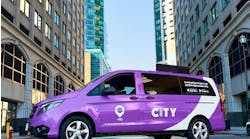Nearly 900 executives from local, national and international companies are registered to attend an Industry Forum today to learn about the $5-billion Landside Access Modernization Program (LAMP) and to receive details about contracting opportunities to build a transportation system for Los Angeles International Airport (LAX).
"LAX is our gateway to the world — and by finally bringing rail to the airport, Angelenos and tourists will be able to connect to Los Angeles' world-renowned neighborhoods and attractions without ever stepping foot in a car," said Mayor Eric Garcetti. "LAMP will transform how L.A. thinks about travel, and get people in and out the airport faster and more conveniently."
LAMP consists of four primary components: an Automated People Mover (APM) system, a Consolidated Rent-A-Car (ConRAC) facility, two Intermodal Transportation Facilities (east and west), as well as roadway improvements to enhance access to the proposed facilities. LAMP is designed to relieve traffic congestion within the LAX Central Terminal Area and on surrounding streets, improve access options and the overall airport guest experience for travelers, and connect via a station to Metro's light-rail system.
"This is a game-changer that is simultaneously making LAX a world-class airport and a first-class neighbor," said council member Mike Bonin, who represents LAX and surrounding neighborhoods on the City Council. "The Landside Access Modernization Program projects are taking cars off the roads of the nearby neighborhoods I represent and making it more convenient for travelers to get to and from LAX."
"The Landside Access Modernization Program is designed to transform the passenger experience at LAX, linking the airport to the City, its attractions, and destinations like never before," said City Council member Bob Blumenfield, chairman of the Los Angeles City Council's Innovation, Grants, Technology, Commerce and Trade Committee, which oversees the airport. "Today we were proud to host potential partners to help make our vision a reality in a way that is environmentally sustainable, fully transparent, and respectful of the surrounding communities."
Of the four project components, Los Angeles World Airports (LAWA) has determined that the Design-Build-Finance-Operate-Maintain (DBFOM) delivery method will be used for at least the Automated People Mover system and the Consolidated Rent-A-Car facility, details of which will be provided at the industry forum.
The APM will be an elevated, 2.25-mile-long airport-transit system with six stations for passenger pick-up and drop-off, pedestrian bridges to airline terminals, parking garages, fixed facilities, and a stop that connects to Metro's county-wide transit system. The people mover will be free, available 24 hours a day, and have short wait times at each station. The APM will also connect to the ConRAC that will accommodate several rental car agencies at one convenient location and be located adjacent to Interstate 405 San Diego Freeway in order to reduce roadway congestion in and around LAX.
LAWA has begun the environmental review and clearance process for LAMP, and is collaborating with key agency and community stakeholders throughout the process. Proposed construction period of the APM and ConRAC projects is from 2017 to 2023. The Los Angeles Board of Airport Commissioners will determine the delivery methods for the other LAMP components at a later date.
Los Angeles Mayor Eric Garcetti tasked LAWA, the city department that owns and operates LAX and two other Southern California airports, with delivering LAMP no later than 2023, while controlling capital costs, minimizing construction impacts on existing LAX operations, and cultivating opportunities for small and local businesses.
"The decision to utilize a delivery method that focuses on working hand in hand with the private sector will help drive innovation and quality, said Sean Burton, president of the Los Angeles Board of Airport Commissioners. "Our preferred delivery approach is reflective of a 21st century solution that will allow us to reach across the global, regional and local marketplace to bring the very best teams together to deliver a complex and innovative structure for one of the world's busiest airports."
The Design-Build-Finance-Operate-Maintain delivery method enables shared risks and rewards, fixed construction costs, and can help ensure project completion dates.
"The DBFOM approach allows for a process that benefits LAWA and is inclusive of our values: comprehensive environmental review, transparency with our communities, project labor agreements, and participation opportunities for local and small businesses," said LAWA chief executive officer Deborah Flint. "This approach will create an exceptional guest experience and cement LAX's competitiveness in the global aviation marketplace."
Public agencies throughout the nation and internationally have successfully used the DBFOM delivery method to build critical infrastructure projects. In comparison to the design-bid-build delivery method, DBFOM can result in cost savings, greater cost control/cost certainty, schedule acceleration, increased access to private-sector innovation, an ability to transfer appropriate risks to the private sector, life-cycle efficiencies, fixed operations and maintenance payments for the life of the project, and reduced administrative costs.
The Industry Forum, held at the Sheraton Gateway Los Angeles Hotel near LAX, is free and open to all industry participants, including prime contractors, subcontractors, suppliers, vendors, and small business enterprises. A networking reception following the five-hour program allowed attendees to meet LAWA executives, small-business enterprises, and other contractors.

